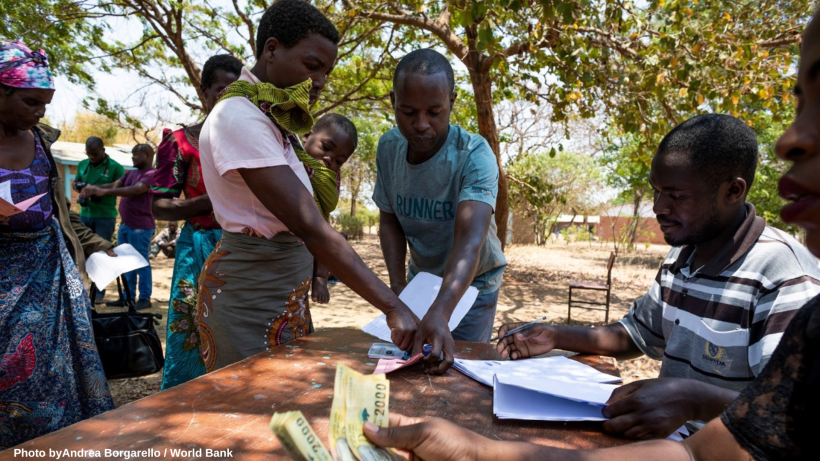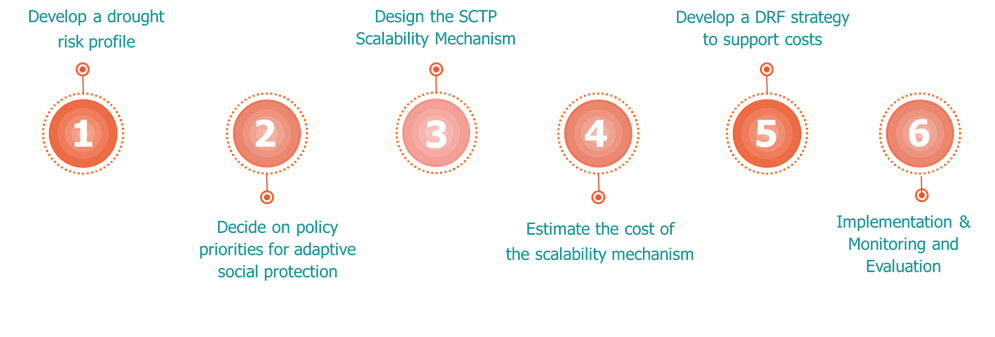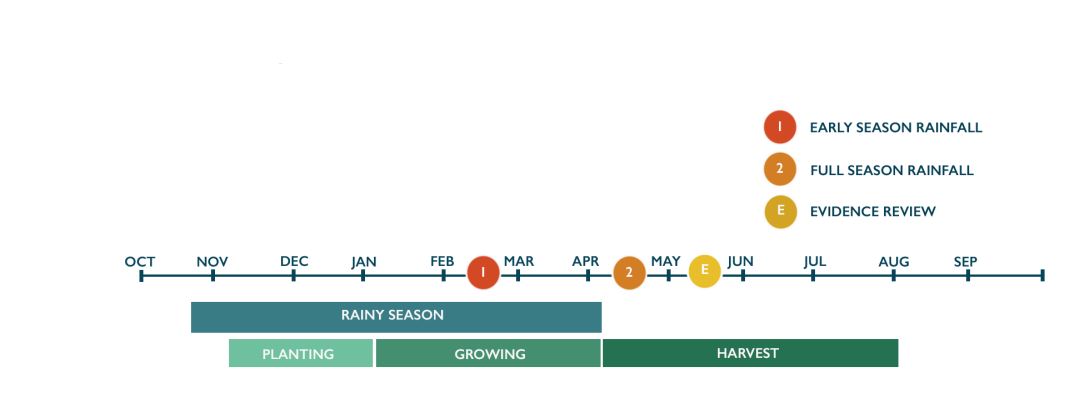Financing Adaptive Social Protection for Drought in Malawi to Protect the Vulnerable

Written by Mulder Mkutumula (Scalable Coordinator, Government of Malawi), Evie Calcutt (Financial Sector Specialist, World Bank), Chipo Msowoya (Senior Social Protection Specialist, World Bank), Alejandra Campero Peredo (Risk Finance Consultant, World Bank)
With an economy that relies heavily on rain-fed agriculture, Malawi is increasingly vulnerable to climate shocks. In recent history, Malawi has seen increases in the frequency and severity of droughts, which cause the poorest and most vulnerable communities the most suffering. Making their social protection programs adaptive to these climate risks is a key pillar of the government’s national strategies on disaster risk financing (DRF) and social protection. By mobilizing finance ahead of a shock, evidence shows the economic impact and loss of livelihoods that occur can be reduced. There are two key issues here to consider. Firstly, the funding sources should be identified and pre-arranged where possible before the shock, ensuring a timely response and avoiding the need to agree on and arrange finance during a crisis. Secondly, no single financial instrument can or should cover all DRF requirements, combining instruments through ‘risk layering’ can be more cost-effective and best cover different levels of shock [1].

The World Bank’s Crisis and Disaster Risk Finance team, through its Disaster Protection Program (funded by the UK), alongside our colleagues from the Social Protection & Jobs Global Practice, have been providing technical expertise and assistance to the Government of Malawi (GoM) on how to use DRF to develop an adaptive social protection mechanism. This is a component of the Social Support for Resilient Livelihoods project (SSRLP).
The resulting ‘scalability mechanism’, uses the government’s flagship Social Cash Transfer Program (SCTP) to scale up assistance in the event of drought. The SCTP targets some of the most vulnerable populations in Malawi, poor households with no labor capacity that cannot participate in other safety net programs, including public works. Through this mechanism, the SCTP systems are leveraged to provide additional cash assistance to poor households in selected districts when they are affected by droughts.
Creating an adaptive SCTP
The GoM developed the scalability mechanism for the SCTP program, following six steps as in Figure 1.
Figure 1: Six steps to designing a scalable mechanism for a social protection program

Source: World Bank.
Steps 1 and 2: Developing a risk profile and identifying policy priorities
Global expertise in different areas was brought together to develop a drought and food insecurity risk profile for Malawi. This is built on multiple existing data sources and risk models covering the country. The risk profile helped to identify key risks and to determine the geographical areas where the scalability mechanism should focus.
A government task force comprising officials from relevant ministries was created to design and implement the scalable mechanism. The World Bank DRFIP produced a learning roadmap to support the task force and provide needed information for designing the mechanism. The learning roadmap helped government officials make informed policy decisions to guide the design of the scalable mechanism.
Step 3: Design the SCTP scalability mechanism
The scalability mechanism monitors rainfall and food insecurity conditions during the agricultural season (November to April) and aims to deliver payouts to households at the point when they are making risk management decisions, such as selling assets or keeping children in school. Providing resources before the next lean season, when food insecurity is at its worst, helps poor households affected by drought avoid negative coping mechanisms.
A dual trigger was established to launch payouts in case of droughts (see Figure 2). The primary trigger monitors rainfall through remote sensing indexes. The secondary trigger consists of an evidence review that gathers information on food insecurity, agricultural production, and food prices. By combining remote sensing indexes with an evidence review, the design ensures that the mechanism is triggered based on objective evidence and helps avoid a mismatch between satellite information and ground conditions, providing appropriate protection for SCTP households when the need arises.
Figure 2: Trigger Structure

Source: Government of Malawi.
More information can be found here:
- “Using Disaster Risk Financing to Build Adaptive Social Protection in Malawi”
- “Technical Analysis to Inform the Trigger Design for Adaptive Safety Nets in Malawi”
Steps 4, and 5: Estimating the cost, and finalizing a DRF strategy to support the cost
Historical data was plugged into the scalability mechanism design to understand the potential range of costs from year to year and the average over the long term. This is then used to determine the funding strategy needed to ensure the funds are available quickly and with a high degree of certainty.
Based on the initial design, the government decided to use a contingency fund to cover regular funding needs (that is, less severe drought years when a small number of districts trigger) and to use a risk transfer instrument to cover the cost of larger scale-ups (that is, years when nearly all districts trigger). The contingency fund, therefore, acts as a deductible to the insurance product, and it sits within the SSRLP. In the first years of implementation, only the contingency finance was available and thus it needed to be a larger pot than in future years when both instruments are available. Funding support or the risk transfer premium is provided by the Global Shield Financing Facility (formally the Global Risk Financing Facility, funded by the UK and Germany).
The government is currently finalizing the procurement of a risk transfer (or insurance) product linked to the primary trigger of the scalable mechanism, to be introduced from the 2023/2024 season. The risk transfer component will be especially important as more districts come on board. It will be the first time such an insurance product has directly backed a risk model for social protection in the African region and this presented procurement challenges for the government.
Step 6: Implementing and evaluating the mechanism
The mechanism rules and financing strategy were documented in the government’s Scalable Handbook part of Malawi’s National Local Government Finance Committee (NLGFC) operational documents for the social protection sector. The mechanism was implemented for the first time during the 2021/2022 rainfall season in three districts (Blantyre, Ntcheu, and Thyolo) covering 74,000 poor and vulnerable households. Following the process, as per the handbook, scaling up was recommended in all districts due to a late onset of rain that resulted in failed plantings; the evidence review showed that livelihoods had also suffered because of a series of cyclones and macroeconomic factors linked to the Russia-Ukraine conflict. The cost of transfers was covered by the SSRLP contingency fund and payouts were made where possible using digital means.
In 2022/2023, the mechanism was expanded to cover over 100,000 households in six districts; the eventual aim is to make it a national mechanism. The GoM is also looking into expanding the mechanism to include other risks and to reach more households through other social protection programs such as public works, and livelihood interventions.

By introducing an adaptative social protection feature to the SCTP, combined with risk financing instruments to cover its costs, the GoM can provide timely and adequate assistance to some of the most vulnerable communities when a shock occurs.
For more information, please contact Mulder Mkutumula, Scalable Coordinator, Government of Malawi (mmkutumula@nlgfc.gov.mw) and Evie Calcutt, Financial Sector Specialist WB, (ecalcutt@worldbank.org), Chipo Msowoya, Senior Social Protection Specialist WB, (cmsowoya@worldbank.org), or Alejandra Campero Peredo, Risk Finance Consultant WB, (acampero@worldbank.org).
Footnote
[1] Disaster Risk Financing: Emerging lessons in financing adaptive social protection, World Bank <https://socialprotection.org/discover/publications/disaster-risk-financing-drf-emerging-lessons-financing-adaptive-social>
The blog has also been published on www.socialprotection.org - Link here